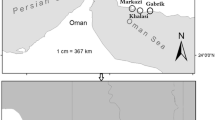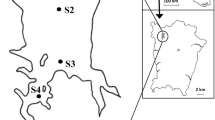Abstract
We collected fish abundance data in the Changjiang (Yangtze River) estuary and adjacent waters in November 1998, May 1999, November 2000, and May 2001. Using the data, we evaluated the characteristics of the fish assemblages at each site and investigated the effect of several environmental factors. We used a multivariate analysis, including community ordination methods such as detrended correspondence analysis (DCA) and canonical correspondence analysis (CCA), and two-way indicator species analysis (TWINSPAN). We analyzed the biological community structure and environmental factors to determine their spatial distributions, temporal dynamics, and seasonal variations. Among the fish species, five exceeded 5% of the total abundance: Harpodon nehereus (42.82%), Benthosema pterotum (13.85%), Setipinna taty (11.64%), Thryssa kammalensis (9.17%) and Apogonichthys lineatus (6.49%). These were separated into four ecological assemblages: hypsithermal-saline, hypsithermal-brackish, hypothermal-brackish, and hypothermal-saline. We evaluated the degree of influence of environmental factors on the fish community. Our analyses suggested that environmental factors including water depth, salinity, turbidity, transparency, nutrient, and suspended matter formed a synthetic spatial gradient between the coastal and pelagic areas. Ecological and environmental factors changed temporally from 1998 to 2001, and drove the fish community succession. The environmental factors driving the fish community structure included bottom temperature, water depth, bottom and surface pH, surface total phosphorous, and bottom dissolved oxygen. This investigation was completed before completion of the Three Gorges Dam; therefore the results of this study provide an important foundation for evaluating the influence of the human activities.
Similar content being viewed by others
References
Abrahams M V, Kattenfeld M G. 1997. The role of turbidity as a constraint on predator-prey interactions in aquatic environments. Behav. Ecol. Sociobiol., 40(3): 169–174.
Akin S, Buhan E, Winemiller K O, Yilmaz H. 2005. Fish assemblage structure of Koycegiz Lagoon-Estuary, Turkey: Spatial and temporal distribution patterns in relation to environmental variation. Estuar. Coast. Shelf., S. 64(4): 671–684.
Akin S, Winemiller K O, Gelwick F P. 2003. Seasonal and spatial variations in fish and macrocrustacean assemblage structure in Mad Island Marsh estuary, Texas. Estuar. Coast. Shelf. S., 57(1–2): 269–282.
de Azevedo M C C, Araújo F G, da Cruz-Filho A G, Pessanha A L M, da Araujo Silva M, Guedes A P P. 2007. Demersal fishes in a tropical bay in southeastern Brazil: Partitioning the spatial, temporal and environmental components of ecological variation. Estuar. Coast. Shelf. S., 75(4): 468–480.
Blaber S J M, Blaber T G. 1980. Factors affecting the distribution of juvenile estuarine and inshore fish. J. Fish. Biol., 17(2): 143–162.
Brown L R. 2000. Fish communities and their associations with environmental variables, lower San Joaquin River drainage, California. Environ. Biol. Fish., 57(3): 251–269.
Elliott M, Dewailly F. 1995. The structure and components of european estuarine fish assemblages. Neth. J. Aquat. Ecol., 29(3–4): 397–417.
Garces L R, Stobutzki I, Alias M, Campos W, Koongchai N, Lachica-Alino L, Mustafa G, Nurhakim S, Srinath M, Silvestre G. 2006. Spatial structure of demersal fish assemblages in South and Southeast Asia and implications for fisheries management. Fish. Res., 78(2–3): 143–157.
Hagan S M, Able K W. 2003. Seasonal changes of the pelagic fish assemblage in a temperate estuary. Estuar. Coast. Shelf. S., 56(1): 15–29.
Hill M O, Šmilauer P. 2005. TWINSPAN for Windows version 2.3. Huntingdon & Ceske Budejovice, Centre for Ecology and Hydrology & University of South Bohemia. Jaureguizar A J, Menni R, Bremec C, Mianzan H, Lasta C. 2003. Fish assemblage and environmental patterns in the Rio de la Plata estuary. Estuar. Coast. Shelf S., 56 (5–6): 921–933.
Killgore K J, Morgan R P, Rybicki N B. 1989. Distribution and abundance of fishes associated with submersed aquatic plants in the Potomac River. N. Am. J. Fish. Manage., 9(1): 101–111.
Kneib R T. 1997. Early life stages of resident nekton in intertidal marshes. Estuaries, 20(1): 214–230.
Leitão R, Martinho F, Cabral H, Neto J, Jorge I, Pardal M. 2007. The fish assemblage of the Mondego estuary: composition, structure and trends over the past two decades. Hydrobiologia, 587(1): 269–279.
Leps J, Šmilauer P. 2003. Multivariate Analysis of Ecological Data using CANOCO. Cambridge University Press, Cambridge.
Levin P, Petrik R, Malone J. 1997. Interactive effects of habitat selection, food supply and predation on recruitment of an estuarine fish. Oecologia 112(1): 55–63.
Liu J Y, Luo B Z. 1992. Impacts of the Three Goreges Project on the ecology and environment of the Changjiang River estuary and adjacent waters. Studia Marina Sinica, 33: 1–13. (in Chinese)
Loneragan N R, Potter I C, Lenanton R C J, Caputi N. 1987. Influence of environmental variables on the fish fauna of the deeper waters of a large Australian estuary. Mar. Biol., 94(4): 631–641.
Luo B Z, Xue P, Lu J W, Huang S F. 1992. Impacts of the Three Goreges Project on the fishery of the Changjiang River estuary and adjacent waters. Studia Marina Sinica, 33: 341–351. (in Chinese)
Maes J, Taillieu A, Van Damme P A, Cottenie K, Ollevier F. 1998. Seasonal patterns in the fish and crustacean community of a turbid temperate estuary (Zeeschelde Estuary, Belgium). Estuar. Coast. Shelf. S., 47(2): 143–151.
Marshall S, Elliott M. 1998. Environmental influences on the fish assemblage of the humber estuary, U.K. Estuar. Coast. Shelf. S., 46(2): 175–184.
Martino E J, Able K W. 2003. Fish assemblages across the marine to low salinity transition zone of a temperate estuary. Estuar. Coast. Shelf. S., 56(5–6): 969–987.
May J T, Brown L R. 2000. Fish community structure in relation to environmental variables within the Sacramento River basin and implications for the Greater Central Valley, California. Report 00-247, U.S. Geological Survey, Sacramento, California, USA.
Menge B A, Olson A M. 1990. Role of scale and environmental factors in regulation of community structure. Trends Ecol. Evol., 5(2): 52–57.
Naiman R J, Latterell J J. 2005. Principles for linking fish habitat to fisheries management and conservation. J. Fish. Biol., 67(Suppl. B): 166–185.
Nero V L, Sealey K S. 2006. Fish-environment associations in the coastal waters of Andros Island, The Bahamas. Environ. Biol. Fish., 75(2): 223–236.
Pomfret J R, Elliott M, O’Reilly M G, Phillips S. 1991. Spatial and temporal patterns in the fish communities in two U.K. North Sea estuaries. In: Elliott M, Ducrotoy J-P ed. Estuaries and Coasts: Spatial and Temporal Intercomparisons. Olsen & Olsen, Fredensborg, Denmark. p. 277–284.
Rice J C. 2005. Understanding fish habitat ecology to achieve conservation. J. Fish. Biol., 67(Suppl. B): 1–22.
Rogers S G, Targett T E, Van Sant S B. 1984. Fish-nursery use in georgia salt-marsh estuaries: the influence of springtime freshwater conditions. T. Am. Fish. Soc., 113(5): 595–606.
Rozas L P, Minello T J. 1998. Nekton Use of salt marsh, seagrass, and nonvegetated habitats in a south texas (USA) estuary. B. Mar. Sci., 63: 481–501.
Sanders H L. 1968. Marine benthic diversity: a comparative study. Am. Nat., 102(925): 243.
Selleslagh J, Amara R. 2008. Environmental factors structuring fish composition and assemblages in a small macrotidal estuary (eastern English Channel). Estuar. Coast. Shelf. S., 79(3): 507–517.
Simier M, Blanc L, Aliaume C, Diouf P S, Albaret J J. 2004. Spatial and temporal structure of fish assemblages in an “inverse estuary”, the Sine Saloum system (Senegal). Estuar. Coast. Shelf. S., 59(1): 69–86.
ter Braak C J F. 1986. Canonical correspondence analysis: a new eigenvector technique for multivariate direct gradient analysis. Ecology, 67(5): 1 167–1 179.
ter Braak C J F. 1987. Unimodal Models to Relate Species to Environment. Agricultural Mathematics Group, Wageningen, the Netherlands.
ter Braak C J F. 1988. CANOCO: an extension of DECORANA to analyze species-environment relationships. Plant Ecol., 75(3): 159–160.
West R J, King R J. 1996. Marine, brackish, and freshwater fish communities in the vegetated and bare shallows of an Australian Coastal River. Estuaries, 19(1): 31–41.
Whitfield A K. 1999. Ichthyofaunal assemblages in estuaries: A South African case study. Rev. Fish. Biol. Fisher, 9(2): 151–186.
Author information
Authors and Affiliations
Corresponding author
Additional information
Supported by the High Technology Research and Development Program of China (863 Program)(Nos. 2006AA09Z180, 2004AA639790), the National Natural Science Foundation of China (No. 40106013), and the National Basic Research Program of China (973 program)(No. 2001CB409703)
Rights and permissions
About this article
Cite this article
Yu, H., Xian, W. The environment effect on fish assemblage structure in waters adjacent to the Changjiang (Yangtze) River estuary (1998–2001). Chin. J. Ocean. Limnol. 27, 443–456 (2009). https://doi.org/10.1007/s00343-009-9155-6
Received:
Accepted:
Published:
Issue Date:
DOI: https://doi.org/10.1007/s00343-009-9155-6




